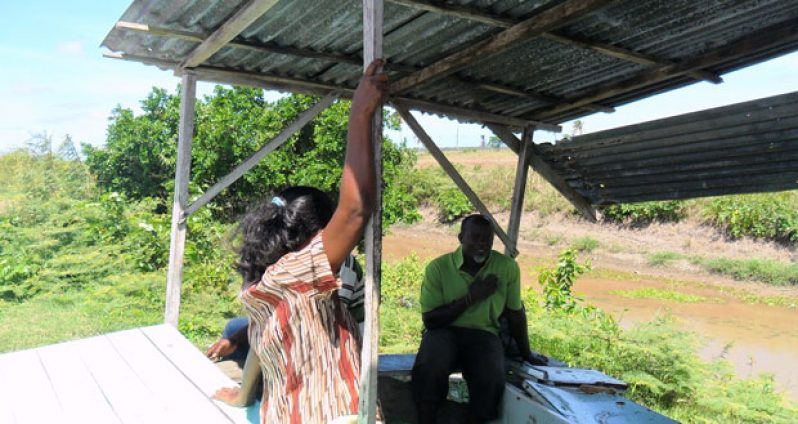MY basic intention this week was to scrutinise, investigate and uncover the secret behind the quaint, enchanting, and very serene aura enveloping the small village of Champagne, located in the fertile backlands of Mahaicony, some 38 miles from the city of Georgetown.
Situated between the Calcutta Backdam and the great expanses of verdant pasture with their wild foliage that extend to the National Rice Research Institute (NARI) rice testing and experimenting entity, Champagne can be found a few minutes’ walk from the now almost desolate settlement of Burma.
At a first glance, one would be tempted to think that Champagne Village is just a haphazard cluster of houses with occupants devoid of the refinement that accompany modernisation. But like they say, ‘never judge a book by its cover’, and we certainly turned the pages of that very exciting novel to discover the glorious mysteries of Champagne Village.
What we discovered was, in some cases, quite appealing, and in other cases very disturbing.
WHAT CHAMPAGNE?
The journey to this almost mystique location was certainly not a pleasant experience. We rattled, skittled and bumped along the deplorable Burma Access Road, yelping in pain sometimes as the old, groaning taxi dropped frequently in and out of huge craters. Finally, with huge sighs of relief, taxi driver ‘Junior Abel’ and I disembarked at the first canal dam that beckoned our entry into Champagne Village.
It was afternoon, and we were greeted with the gleeful laughter of a few young girls playing hop-scotch on the main dam leading to the cluster of houses just a short distance ahead. Somewhat surprised at our entrance, the little ladies looked up sharply, sweeping us up and down, their eyes locked onto my pen, writing pad, camera and media identification card.
This, I believe, prompted the soft, pleasant greetings of “Good afternoon sir”, before they resumed playing their games; but they observed our actions every now and then in childish curiosity.
Stopping to chat with residents at the first house, a few males raised questioning eyebrows, but the two females there swinging in hammocks were all welcoming smiles. One, who appeared to be a grandmother, mouthed a toothless grin. “Good afternoon uncle… wha wrang? How awe can help yuh?”
My soul was instantly at ease, and with reciprocal warmth, I went into detailed explanation of the reason for my visit. What I said apparently excited the males, and two of them readily offered to give us a grand tour of the small village, smoothing their shirts and fixing their apparel in anticipation of our acceptance of their offer.
IS THIS CHAMPAGNE?
Well, I had actually thought that the cluster of houses before our eyes was all that comprised the village, but I was greatly in error, since this village seemed to stretch for miles into the backdam area, where more houses, rice fields, and several farms and kitchen gardens became visible.
The scenery was so breath-taking that it had me wondering why someone hadn’t discovered the fairytale spectacle that was this very beautiful, pristine and quaint village. How I marvelled at the ‘spic and span’ appearance of the apparently white-washed surfaces under the houses; but investigations revealed that, to avoid cracking, the earth beneath the houses had actually been daubed with a mixture of cow dung, water, and a special type of mud. When that mixture dries, it gives the earth such an inviting appearance that one cannot help feeling inclined to lie down and curl up on that surface.
And believe me, readers: when that mixture dries, it has a strangely alluring scent that seemingly infects one’s senses with what I can only describe as ‘a cozy magic’.
There is no village signboard to indicate one’s arrival in Champagne Village; and, strangely, none of the residents could give information on the history of this village. The village also could not be located on the Internet, but vegetable farmer Jagdeo Persaud, aka ‘Uncle Sonny’, shared the little he knew about the location, having resided in Champagne Village for over forty years.
Uncle Sonny indicated that what is now the quaint little village used to be sprawling pastures, dense bush and stubborn foliage in times past. Like many other countryside villages, he said, Champagne was discovered by curious farmers who found out that the land was rich for farming, and began to target the land firstly for small-scale rice cultivation, which eventually evolved into the very extensive rice fields that are now present.
Uncle Sonny said persons soon began purchasing plots of land in the area, and gradually the village evolved into what it is today. He said that, as far as he knows, the village was named by one of the very early settlers who had many plots of land there and felt that his surname was most suited for the intended village.
LIVELIHOOD
Champagne Village is primarily populated by pleasant and jovial East Indians who live in perfect harmony. Villagers depend almost entirely on rice farming and vegetable cultivation for their existence. This almost total dependence on agricultural activities is evident from the many farms that stretch into the backlands, and the kitchen gardens that proliferate in almost every homestead.
Even as we drove around the village, our tummies rumbled in reaction to the appetizing aromas of either deep fried or stewed fresh vegetables that wafted to us from bubbling stewpots set on stoves or ‘cackling firesides’.
Some persons reared poultry, which provided eggs and meat for consumption; while a few thrived on the rearing and sale of sturdy and very healthy cattle. Strangely, there is not even one shop or grocery store in the village, and residents mentioned that they would normally journey to the nearby village of Calcutta, or travel five miles away to Central Mahaicony, to obtain what groceries and household supplies they need.
CONSTRAINTS
I would have to concede that, of all the villages I have visited, Champagne appealed most to me with its fairytale quaintness and serene simplicity.
For most of the day, the village is engulfed in dust from vehicles traversing the unpaved streets, and the large trucks using the badly damaged Burma Access Road which is situated on the windward side just a few rods in front of the village.
Housewives and mothers were seen busily flipping roti on their ‘tawahs’ or readying sweet smelling stews for lunch.
Husbands devouring ‘float bakes’ or ‘sada roti’ and fried salted fish lamented that children attending school suffer the most, since mini-buses or cars hardly traverse the Burma Road because of its condition. Students from Champagne Village travel to either the Novar Secondary (three miles away) or the Mahaicony Secondary, which is some five miles from their location; and they use the Burma Access Road. With transportation allegedly lacking almost every day, students inevitably arrive late to school almost every day, thus hampering their academic accomplishments.
Speaking for a group of young men liming in the streets, 19-year-old Salim Razack noted that “there is no scope” for academically qualified youths in the village. He said several individuals would normally excel at the CSEC examinations, but they remain in the village being unemployed, or are forced to engage in farming like their parents and grand-parents.
Villagers are also crying out for the providence of a proper bus shed within which to await transportation, since the makeshift structure erected by some young men in the village does not shelter users from either the scorching sun or torrential downpours.
The complaining voices of young men in the streets tugged at my heart strings as they voiced the need for recreational opportunities in the village.
Some mothers referred to their village as ‘the land that is forgotten’, amidst peals of girlish laughter.
There are no nightclubs or discos in this village, and villagers depend on occasional weddings and birthday parties at which the forty-plus households can “twitch their hips and roll their bellies in dancing abandon”.
RICE WOES
Rice farmers in Champagne are complaining of facing difficulties in obtaining an adequate supply of water for their rice crops. Rice farmer Vijay Vishnu noted that, for years, farmers were plagued with improper drainage and irrigation, and it has resulted in major losses not only on their rice farms, but on vegetable plots as well. While he is thankful that the Mahaicony NDC has recently dug the main canal in the village, to increase water flow, he however notes that, because of the dry weather, the water level in this canal is still inadequate to supply water to rice fields, which keep expanding rapidly. As such, he said, farmers are forced to rent irrigation pumps for exorbitant fees, to ensure that their harvests are not completely lost or damaged.
Rice farmers are also forced to solicit milling services miles away, because the Mancott Rice Milling Complex, located at the back of the village, has been seized by a commercial bank for one reason or the other, and actually never went into operation.
Villagers said the large, state-of-the-art rice complex would have greatly offset freight costs at harvest time; but what remains now is almost a shell of the complex, since, although there was security at the complex, a large quantity of expensive heavy duty equipment has been stolen by outsiders.
The village is also in dire need of maintenance in many areas, as was evident by the dense vegetation surrounding many homes and farm lands.
CONCLUSION
With its vast, majestic pastures; lush rice fields; numerous fish ponds, and sandy streets, Champagne Village takes on the enchanting appearance of a ‘yesteryear paradise’ dying to be remembered and resuscitated.
It surely can become yet another ‘tourist masterpiece’ if the correct masterminds are made to discover its ‘hidden beauty and boundless potential’.
By Alex Wayne




.png)
















